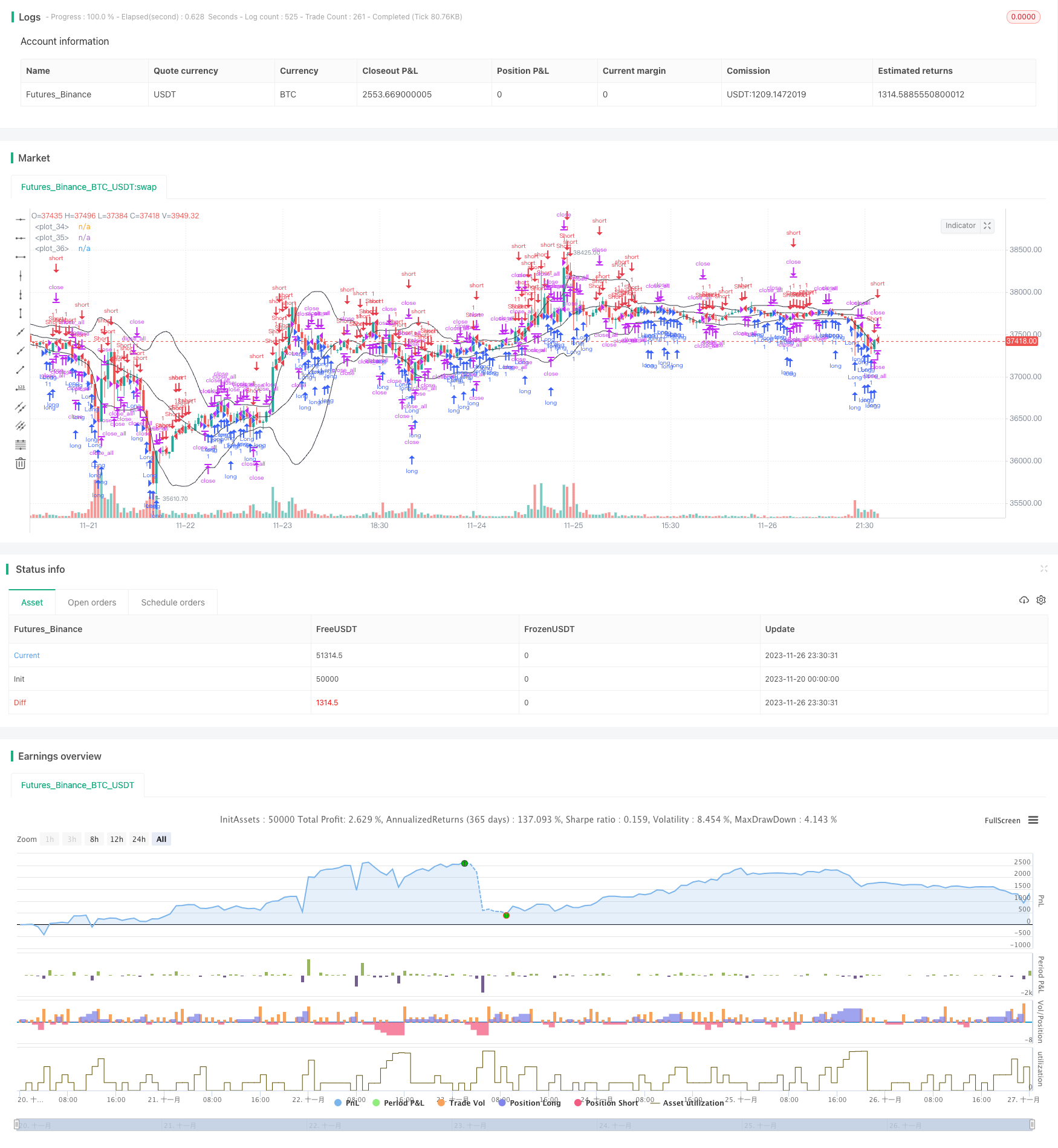
概述
该策略是一个基于布林带的动量波动追踪策略。它结合布林带指标判断市场趋势和反转点,通过设置多空仓位追踪市场波动。
策略原理
该策略的核心指标是布林带。布林带由中轨、上轨和下轨组成。中轨是n天的移动平均线,上下轨分别是中轨加减标准差的偏移。当价格接近上下轨时视为超买超卖的信号。策略加入趋势偏离作为建仓的依据,即当价格反向突破中轨时开仓。为防止假突破造成亏损,策略要求开仓突破幅度大于均值。平仓条件是突破中轨后价格再次回折。
该策略同时加入了趋势性建仓和反转型建仓,分别对应不同的交易机会。趋势性建仓要求中轨作为支撑阻力参考,形成突破偏离的效果。反转型建仓则直接在布林带上下轨附近反转形成。策略通过组合这两种启示,能够兼顾趋势追踪和反转操作。
优势分析
该策略结合布林带的超买超卖特征,加入反转点判断。这使得其能够同时适用于趋势市和震荡市,捕捉不同类型的交易机会。策略的止损 Exit 设置防止了亏损扩大。多空双向交易的特点也增强了策略的适用性。
相比简单布林带策略,该策略加入的趋势逻辑判断使得建仓更稳定,同时也抓住了反转机会。这让信噪比得到提升。其次,多空双向交易也比较全面的利用了不同市场的交易机会。
风险分析
该策略主要依赖布林带的超买超卖特征。所以当价格出现剧烈波动时,布林带区间会不断增加,容易导致多次亏损建仓。这是潜在的风险点。此外,反转判断依然有一定的不确定性和误差,会造成失败的建仓和停损。
针对布林带失效的情况,可以缩短n天参数,使布林带更灵敏。或者减小它的幅度范围,降低造成亏损的可能。对于反转曲线判断,则可通过优化突破的参数来减少错误。
优化方向
该策略可优化的方向主要有以下几个: 1. 布林带的参数可根据不同市场调整,找到最佳的参数组合。 2. 趋势偏离的幅度和均值的计算方式可以测试其他选项。 3. 加入更多过滤器判断建仓信号,减少误判概率。 4. 可测试止损方式,如trail停损等其他模式。 5. 可以针对特定品种、周期进行参数调优。
总结
该策略对布林带标准策略进行了有效的扩展与优化。加入的趋势偏离判断提高了稳定性,利用好了反转机会。多空双向交易和止损设置也让策略更加健壮。通过参数优化和加入更多过滤器,可进一步提高效果
/*backtest
start: 2023-11-20 00:00:00
end: 2023-11-27 00:00:00
period: 30m
basePeriod: 15m
exchanges: [{"eid":"Futures_Binance","currency":"BTC_USDT"}]
*/
//Noro
//2018
//@version=3
strategy("Noro's Bollinger Strategy v1.3", shorttitle = "Bollinger str 1.3", overlay = true, default_qty_type = strategy.percent_of_equity, default_qty_value = 100.0, pyramiding = 5)
//Settings
needlong = input(true, defval = true, title = "Long")
needshort = input(true, defval = true, title = "Short")
length = input(20, defval = 20, minval = 1, maxval = 1000, title = "Bollinger Length")
mult = input(2.0, defval = 2.0, minval = 0.001, maxval = 50, title = "Bollinger Mult")
source = input(ohlc4, defval = ohlc4, title = "Bollinger Source")
uset = input(true, defval = true, title = "Use trend entry")
usect = input(true, defval = true, title = "Use counter-trend entry")
fromyear = input(2018, defval = 2018, minval = 1900, maxval = 2100, title = "From Year")
toyear = input(2100, defval = 2100, minval = 1900, maxval = 2100, title = "To Year")
frommonth = input(01, defval = 01, minval = 01, maxval = 12, title = "From Month")
tomonth = input(12, defval = 12, minval = 01, maxval = 12, title = "To Month")
fromday = input(01, defval = 01, minval = 01, maxval = 31, title = "From day")
today = input(31, defval = 31, minval = 01, maxval = 31, title = "To day")
showbands = input(true, defval = true, title = "Show Bollinger Bands")
//Bollinger Bands
basis = sma(source, length)
dev = mult * stdev(source, length)
upper = basis + dev
lower = basis - dev
//Lines
col = showbands ? black : na
plot(upper, linewidth = 1, color = col)
plot(basis, linewidth = 1, color = col)
plot(lower, linewidth = 1, color = col)
//Body
body = abs(close - open)
abody = ema(body, 30)
//Signals
bar = close > open ? 1 : close < open ? -1 : 0
up1 = bar == -1 and ohlc4 >= basis and ohlc4 < upper and (close < strategy.position_avg_price or strategy.position_size == 0) and uset
dn1 = bar == 1 and ohlc4 <= basis and ohlc4 > lower and (close > strategy.position_avg_price or strategy.position_size == 0) and uset
up2 = close <= lower and usect
dn2 = close >= upper and usect
exit = ((strategy.position_size > 0 and close > open) or (strategy.position_size < 0 and close < open)) and body > abody / 2
//Trading
if up1 or up2
strategy.entry("Long", strategy.long, needlong == false ? 0 : na, when=(time > timestamp(fromyear, frommonth, fromday, 00, 00) and time < timestamp(toyear, tomonth, today, 23, 59)))
if dn1 or dn2
strategy.entry("Short", strategy.short, needshort == false ? 0 : na, when=(time > timestamp(fromyear, frommonth, fromday, 00, 00) and time < timestamp(toyear, tomonth, today, 23, 59)))
if time > timestamp(toyear, tomonth, today, 23, 59) or exit
strategy.close_all()